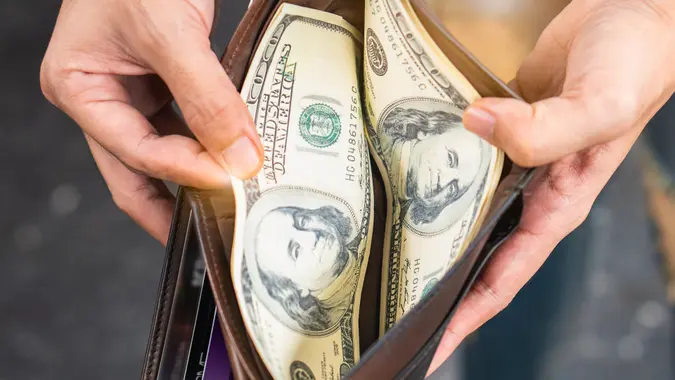Rainy Day Fund: What Is It and How Much Do You Need to Save

Commitment to Our Readers
GOBankingRates' editorial team is committed to bringing you unbiased reviews and information. We use data-driven methodologies to evaluate financial products and services - our reviews and ratings are not influenced by advertisers. You can read more about our editorial guidelines and our products and services review methodology.

20 Years
Helping You Live Richer

Reviewed
by Experts

Trusted by
Millions of Readers
A rainy day fund is a small cash reserve that can help you get through a small, unexpected expense. Here’s how to build it and when to use it.
Is a Rainy Day Fund the Same as an Emergency Fund?
| Rainy Day Fund | Emergency Fund |
|---|---|
| For small, unexpected expenses | For major life disruptions |
| Example: Medical co-pay, minor car repair | Example: Job loss, Major bills |
| $500-$2,000 | 3-6 months of expenses |
A rainy day fund is meant to be smaller than an emergency fund. Financial experts recommend that your emergency fund be able to cover 3-6 months of monthly expenses.
How Big Should Your Rainy Day Fund Be?
There is no one right amount for how large your rainy day fund should be. A good place to start is to set aside at least a few hundred dollars.
Real-Life Examples of Rainy Day Fund Usage
A rainy day fund can come in handy when you least expect it, which was the case for Ruth King, Founder and CEO of FinanciallyFit.business, and her family. When her daughter started her first job as a teen, she encouraged her to set aside 1% to 2% of her paycheck into a savings account.
“She didn’t like it, but she did it,” King told us. “When she was in college, she had an unexpected minor truck accident” (too small for the deductible). “She had the money to fix her truck. She told me she now understood why I “made her” put the money away and was glad she had it. Now, she is 35 years old and still does it.”
Strategies for Building a Rainy Day Fund
When planning your rainy day fund, there are many ways to approach saving, but thinking of it as part of your budget can help you be more successful.
Here’s a few other key strategies to help create a rainy day savings:
- Use a good budgeting app. There are many easy-to-use, free ones are available. You can also use a spreadsheet, or paper and pencil.
- Commit to a plan. Decide what you can do based on your budget, knowing that it’s about being consistent. You may start by transferring just $10 to a savings account every week. If you were to do this, you’d have more than $500 in a year.
- Make it automatic. Most financial institutions allow you to set up automatic transfers from a checking account to a savings account.
- Save cash windfalls. If you have a one-time financial gain (e.g., tax refund, commission check, proceeds from a garage sale) coming, put it toward the fund.
- Get creative with generating extra income. Get organized and sell unneeded items online or hold a yard sale. Devote all proceeds to the fund.
Common Mistakes to Avoid
Having a rainy day fund can help keep your finances on track, but there are a couple things to avoid:
- Don’t pull from your rainy day fund unless it’s really an emergency. That way it’s there when you really need it.
- After you pay for an emergency, make a plan to replenish your rainy day fund.
Organizing Your Rainy Day Fund
Creating new accounts for all of your savings goals can help you stick to it. For example, you can have an account for your:
- Rainy day fund
- Emergency fund
- Vacation savings
Start small, with $10 a week. In a year, you’ll have $520.
Frequently Asked Questions (FAQs)
- What is a rainy day fund?
- A rainy day fund is for small surprise expenses, like a flat tire.
- How much should I keep in a rainy day fund?
- A good place to start is $500-$2,000
- Is a rainy day fund different from an emergency fund?
- Yes. A rainy day fund is meant for smaller expenses than an emergency fund. Emergency funds are meant for job loss or major medical bills.
- How should I organize my savings goals?
- Some banks allow you to create different categories with your savings accounts. This can help you separate your money into a rainy day fund, an emergency fund and a vacation savings.
 Written by
Written by  Edited by
Edited by 
























